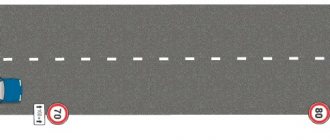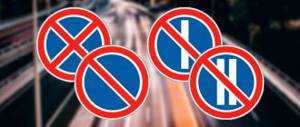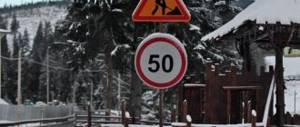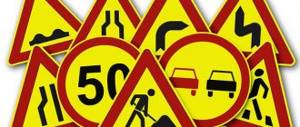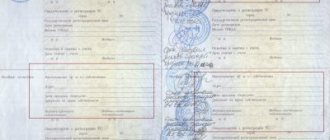Maximum permitted driving speed in the city
In addition to the norms established by section 10 of the traffic rules, every driver must also navigate the limiting road signs. One of them is sign 3.24, which is installed to limit the permissible speed according to the law.
On sections of roads where this sign is present, it is prohibited to drive faster than the speed indicated on it. Quite often it is installed together with plate 8.4.1 - 8.4.8 “Type of Vehicle”, so the restriction applies exclusively to the vehicles indicated on the plate and has no relation to other categories of vehicles.
According to the traffic rules, populated areas are built-up areas, the beginning and end of which are indicated by road signs 5.23.1 – 5.26. These signs exist to designate the territory within which it is necessary to adhere to the speed established specifically for cities and other types of populated areas.
But it is important to take into account that the restriction comes into force only if there are signs 5.23.1 and 5.23.2 indicating the beginning of this territory. Other similar signs indicate that the rules established for a built-up area do not apply on this section of the road.
- Prices
- Characteristics
- Test Drive
- Four-wheel drive
- Trunk
- Photo
- Video review
- News
- Lada Vesta Cross sedan
- Prices
- Characteristics
- Test Drive
- Trunk
- Photo
- Video review
- release date
- News
How much can you exceed the speed limit?
Before getting a driver's license, I often heard from my friends, both those who were drivers and those who were not, that when driving a vehicle it is permissible to exceed the speed limit by 20 km/h for a given area. .
This is interesting: Complaint to the prosecutor's office against an employer
However, when I personally went to take my driver’s license and began to study the traffic rules, I came across the fact that, in fact, exceeding the specified speeds on road sections is not the norm. That is, this is a violation of traffic rules, they just don’t issue a fine for these “extra” 20 km/h.
Let's look at this issue in a little more detail - find out what speeding is permissible and what the consequences of such a violation of traffic rules are.
Traffic speed outside the city in 2021
Let's look at the features of installing 3.24 signs, which are unknown to most drivers. The point is that if a section of the road has a low speed limit, then the signs should be installed in steps of 20 km/h. This is regulated by the requirements of GOST R 52289-2004 (clause 5.4.22):
If a maximum speed is set on a given section that differs from the maximum permitted speed on the previous section by 20 km/h or more, a stepped speed limit is applied in increments of no more than 20 km/h by sequentially installing signs 3.24 at a distance of 100-150 m from each other. friend.
A stepped speed limit may not be applied in front of a populated area indicated by sign 5.23.1 or 5.23.2 if the visibility distance of the sign is more than 150 m.
Thus, when organizing repairs on country roads, a combination of signs “70 - 50 - 40” can be used and a separate sign “40” cannot be used. Otherwise, installing the sign is a violation of GOST requirements.
In practice, when driving outside the city, you can come across signs 3.24, the effect of which is not canceled by anything . Their effect can extend tens of kilometers to the nearest populated area.
This state of affairs does not please drivers, but in the described case it is necessary to adhere to the speed indicated on the prohibiting sign.
On country roads you can also find information sign 6.2 “Recommended speed”:
6.2 "Recommended speed". The speed at which it is recommended to drive on this section of the road. The sign's coverage area extends to the nearest intersection, and when sign 6.2 is used together with a warning sign, it is determined by the length of the dangerous area.
The Code of Administrative Offenses does not provide for a separate article containing punishment for driving at too low a speed (if there is a 4.6 sign). However, for this violation the driver may be punished under Part 1 of Article 12.16 for failure to comply with the requirements of road signs.
For too low a speed, you can receive a warning or a fine of 500 rubles .
Note. In this case, it does not matter how much the car’s speed was less than the value indicated on the sign. The fine will be the same.
Good luck on the roads!
Avtodor talked about increasing the speed limit in 2021
Unlike the vast majority of types of traffic violations, violation of the speed limit is easily recorded using technical means of control. A fine for speeding can be automatically recorded by traffic police cameras. In other words, if only a human inspector can determine an unfastened seat belt or different types of tires on one axle of a car, then a computer is enough to determine the speed of a particular vehicle.
Exceeding the set speed of the vehicle by an amount... (gradation from 0-20 km/h to 80 km/h or more), in increments of 20 km/h. Incurs the imposition of an administrative fine in the amount of 500 rubles. (250 rubles with a discount) up to 5000 rubles (2500 rubles with a discount).
In some cases, the speed limit was exceeded by more than 60 km/h. real traffic police officers provide for such a penalty as deprivation of a driver's license.
If any excess of speed is detected by special technical means operating in automatic mode, which have the functions of photography, filming, and video recording, deprivation of a driver’s license is not provided.
The country's motorists are, of course, interested in what level of speeding on the road does not lead to a fine in 2021, how many kilometers per hour is it allowed to accelerate a car without falling under traffic rules?
In the current conditions, when the legislator has actually exempted drivers from paying traffic police fines for speeding by Russian drivers who want to move at maximum speed, but not receive speeding fines, the following trick is used.
An additional 20 km/h is added to the number on road signs limiting the speed of 30,40, 50, 60, 70, 80, 90 and 110 km/h.
| Maximum, non-punishable speed in the city | 80km/h. |
| The maximum non-penalized speed within the sign's coverage area is 40 km/h. | 60km/h. |
| Maximum, non-punishable speed outside the city | 110 km/h. |
| Maximum, non-punishable speed outside the city on the motorway | 130km/h. |
| Maximum, non-punishable speed in the city | 80km/h. |
| The maximum non-penalized speed within the sign's coverage area is 40 km/h. | 60km/h. |
| Maximum, non-punishable speed outside the city | 110 km/h. |
| Maximum, non-punishable speed outside the city on the motorway | 130km/h. |
As we all remember very well from school life safety courses, it is impossible to stop a large vehicle in a matter of seconds. Large mass adds inertia. It is for this reason that the legislation of most developed countries strictly limits the speed on roads within populated areas at 40-50 km/h. Here, the danger can be unexpected; buildings, stops, and trees that interfere with the driver’s view often hide people and animals that instantly find themselves on the roadway.
In April 2021, the traffic police took the initiative to change the tariffs of fines for minor speeding.
According to Oleg Ponaryin, Deputy Head of the Main Directorate for Road Safety of the Ministry of Internal Affairs of the Russian Federation, “This, on the one hand, will help curb the constant growth in the number of violators. On the other hand, we consulted with the Federal Bailiff Service, and this will give them the opportunity to collect fines in a simplified manner.”
The traffic police also proposes to take away discounts on fines from citizens who often exceed the speed limit and introduce special increased coefficients for reckless drivers.
How much are the current speeding fines?
So, let's now take a closer look at each standard of responsibility. As you can see from the table of fines above, they are divided depending on the amount of excess - the faster you move from the permitted speed, the higher the amount of the sanction will be.
At 1-20 km/h
As we learned above, there is no fine for exceeding no more than 20 km/h in 2021. That is, punishment is possible only if you drive 21 km/h or more faster (taking into account the error set in the auto-fixation means, this value can be increased by another 1-2 kilometers).
Why exactly these values? Because the official interpretation in the Code of Administrative Offenses says exactly this: “Exceeding the established speed of a vehicle by more than 20...”. More than 20 is 21 km per hour and above.
So, as examples:
- if you are driving in a populated area where there are no additional restrictions with signs and not in a residential area or yard at a speed of no more than 79 km/h, then there will be no fine,
- on the highway this value is 109 km/h,
- on the highway – 129 km/h.
Previously, there was a penalty of 100 rubles for exceeding 10 km/h, but it was abolished almost 8 years ago.
At 20-40 km/h
And this is where the financial burden begins.
The traffic police fine for speeding by 20 to 40 (inclusive) km/h is 500 rubles under Part 2 of Article 12.9 of the Code. And this is the most common fine for all traffic violations in Russia, thanks to the extensive introduction of photo recording cameras. That is, drivers most often receive letters by mail with a decision specifically under Part 2 of Article 12.9. Subtleties of a fine for exceeding 20-40 km/h
| Rule of law | Article 12.9, part 2 of the Code of Administrative Offenses |
| Amount of fine | 500 rubles |
| Is there a discount? | – you can pay 250 rubles in the first 20 days from the date of the decision |
| Do auto-fixing cameras detect? | Yes |
| Is there repetition? | No |
| Amount of repeated fine | 500 rubles |
Expert opinion
Dmitry Tikovenko
Automotive law expert. 7 years of experience. Areas of specialization: civil law, disputes over compulsory motor liability insurance and road accidents
It is important to pay the fine for speeding within the period established by law. Delay can cause a lot of trouble - ranging from prosecution under Article 20.25 of the Code of Administrative Offenses of the Russian Federation with payment of twice the fine plus the original fine, as well as arrest for 15 days or compulsory labor for 50 hours, ending with a ban on registration actions when collecting a fine by bailiffs. Therefore, it is better to take advantage of the discount and pay.
Ask a Question
At 40-60 km/h
Here, drivers will face a more severe punishment in the form of a fine, but ranging from 1 to 1.5 thousand rubles. And again, examples when this traffic police fine is applied:
- the road sign “40” in the city sets a limit, but you are driving in excess - at a speed of 85 km/h,
- on a highway without any signs you are moving 149 km/h (limit 90).
Subtleties of a fine for driving 40-60 km/h faster than the norm
| Rule of law | Article 12.9, part 3 of the Code of Administrative Offenses of the Russian Federation |
| Amount of fine | 1,000 – 1,500 rubles |
| Is there a discount? | – you can pay 500-750 rubles in the first 20 days from the date of the decision |
| Do auto-fixing cameras detect? | Yes |
| Is there repetition? | Yes |
| Amount of repeated fine | 2,000 – 2,500 rubles |
At 60-80 km/h
The next gradation of fines for speeding establishes liability for more serious violations of the speed limit.
And this is the first rule where deprivation of rights is applied. Subtleties of a fine for exceeding 20-40 km/h
| Rule of law | Article 12.9, part 4 of the Administrative Code |
| Amount of punishment | Traffic police fine 2,000 – 2,500 rubles or deprivation of rights for 4-6 months |
| Is there a discount? | – you can pay 1,000 – 1,250 rubles in the first 20 days from the date of the decision |
| Do auto-fixing cameras detect? | Yes |
| Is there repetition? | Yes |
| Amount of repeated fine | 5,000 rubles or imprisonment for 1 year (if on camera, then only a fine) |
More than 80 km/h
And now we have reached the maximum sanction, establishing the punishment for the last gradation of speeding - a 5,000 ruble fine or deprivation of rights for six months.
At the same time, it does not matter how much more than 80 km/h you exceeded - the sanction will be the same.
For example, you are driving at a speed of 150 km/h in the city (the limit is 60) - there will be this standard of responsibility; if you are driving at a speed of 280 km per hour, then the same penalty will apply. Subtleties of a fine for exceeding 20-40 km/h
| Rule of law | Article 12.9, part 5 of the Administrative Code |
| Amount of punishment | Fine 5,000 or imprisonment for six months |
| Is there a discount? | – you can pay 2,500 rubles in the first 20 days from the date of the decision |
| Do auto-fixing cameras detect? | Yes |
| Is there repetition? | Yes |
| Amount of repeated fine | 5,000 rubles if detected by a photo recording device or deprivation of rights for 1 year if detected by a traffic police officer |
Repeated sanctions
There are 2 more parts of Article 12.9 in the Administrative Code, which establish the liability that threatens if you repeatedly exceed the permitted speed by at least 40 km/h within a year.
- Part 6 of Article 12.9 provides for a fine of 2-2.5 thousand rubles for repeated speeding by 40-60 km/h (if the first resolution was under Part 3 of this article).
- And part 7 of this norm already provides for the deprivation of rights for 1 year or a fine of 5,000 as an alternative, if the violation is detected on an auto-fixation camera, for exceeding more than 60 km/h (if for the first time you were charged under Part 4 or 5 of Article 12.9 ).
A little below we will explain in more detail how repeated punishments work in the administrative legislation of 2021.
What is the maximum fine amount in 2021?
So, above we found out that the biggest sanction for speeding today is the deprivation of rights for 1 year - for repeated driving faster than at least 60 kilometers per hour from the permitted limit.
If we talk only about the amount of the fine, then it is 5 thousand rubles, and is imposed either for exceeding more than 80 km/h, or for repeatedly exceeding more than 60 km/h. But the latter option is possible in the form of a fine only if the violation was recorded by an automatic photo or video camera.
Permissible speed limit in 2021
The amount of the fine for speeding is regulated by Article 12.9 of the Code of Administrative Offenses of the Russian Federation. The regulatory legal act was amended on 04/04/17.
If a citizen violates the speed limit, the following fines will be applied to him:
- 500 rubles if the permissible speed was exceeded by 20-40 km/h. The incident will be investigated by the internal affairs bodies.
- 1-1.5 thousand rubles, if the driver was driving 40-60 km/h faster than the established norm. The decision to impose a fine is made by the State Traffic Safety Inspectorate.
- 2-2.5 thousand rubles. or suspension from driving for up to 0.5 years if the driver exceeded the speed by 60-80 km/h. The case can be considered in court or by representatives of the traffic police.
- 5 thousand rubles if the speed was exceeded by more than 80 km per hour. The punishment may be replaced by deprivation of rights. A person will not be able to drive a vehicle for 0.5 years.
If a person is caught violating the law again, the punishment becomes more severe. In the case where the speed limit was 40-60 kilometers per hour, the fine will increase to 2.5 thousand rubles. If a person repeatedly drives more than 60 km/h faster than the norm, he will be disqualified from driving for one year. If the violation was recorded by cameras, the driver will get off with a fine for speeding in the amount of 5 thousand rubles.
The process of recognizing speeding as repeated is regulated by Article 4.6 of the Code of Administrative Offenses of the Russian Federation. It states that the person subject to the penalty will be considered subject to it after the order comes into force. The term will end in a year. This means that the violation was committed again if the person violates the speed limit again within 12 months from the date of the decision.
It comes into force:
- 10 days after the document was served on the violator, or after filing a complaint about the legality of the previously issued decision;
- after 1 day, if a complaint against administrative arrest was filed;
- after 60 days, if a person complained about a previously imposed fine.
It is considered that a citizen has committed a repeated offense if he exceeds the speed limit the next day after the decision on a fine for a similar violation comes into force.
The speed limit is determined in accordance with the provisions of the traffic rules. Chapter 10 is devoted to issues related to the concept. the above collection of normative legal acts. The speed of movement that is allowed in a particular area is influenced by a whole list of factors.
The list includes:
- type of road;
- location of the road surface;
- type of vehicle;
- the purpose for which the citizen went on a car trip.
To clearly understand what speed is allowed in a given situation, you should familiarize yourself with the table below. The specified values may be exceeded if appropriate signs are present. In this situation, no fine will be issued. You cannot increase the speed above the values that apply for driving on the motorway.
Table of fines for speeding in 2021:
| Maximum speed allowed for vehicles weighing up to 3500 kg (in kilometers per hour) | ||||
| In the city | Residential areas | Highways | Other routes outside populated areas | |
| The car drives on its own | 60 | 20 | 110 | 90 |
| The car is towing another vehicle | 50 | 50 | ||
| Trailer being towed | 60 | 90 | 70 | |
| Permissible speed limit in km/h for vehicles weighing up to 3500 kg. | ||||
| Settlements | Roads in courtyards or residential areas | Trails | Other roads located outside cities and villages | |
| The car moves independently | 60 | 20 | 110 | 90 |
| A car is towing another vehicle | 50 | 50 | ||
| Trailer being towed | 60 | 90 | 70 | |
| Limits in km/h for vehicles weighing more than 3500 kg. | ||||
| Cities, villages, villages, etc. | Traffic in residential areas | Highways | Other roads outside populated areas | |
| The car moves on its own | 60 | 20 | 90 | 70 |
| A car is towing another vehicle | 50 | 50 | ||
| There are passengers in the back | 60 | 60 | ||
| The car is moving with a trailer | 60 | 90 | 70 | |
| Established limits in km/h for intercity buses with a small number of seats and motorcycles | ||||
| Settlements | Yards and other residential areas | Moving along the highway | Other roads outside populated areas | |
| Standard ride | 60 | 20 | 90 | |
| The car is towing another vehicle | 50 | 50 | ||
| Children are transported in vehicles | 60 | 60 | ||
| Maximum speed in km/h for other vehicles for the transport of persons | ||||
| Settlements | Yards and other residential areas | Driving on the motorway | Other roads outside populated areas | |
| Self-driving vehicle | 60 | 20 | 90 | 70 |
| The car is towing another vehicle | 50 | 50 | ||
| Transportation of a group of minors | 60 | 60 | ||
If the vehicle is used to transport special loads, the vehicle is subject to a special speed limit. Exceeding it will result in a fine. The speed of the vehicle is agreed upon during the delivery transaction. Exceeding the limit will be considered a violation. Regardless of the speed limit, at a zebra crossing the driver must stop and let the pedestrian pass.
To apply a fine for exceeding the speed limit by 20 km/h, traffic police officers are required to measure it. Radars are used for this. However, there are a number of rules that traffic police officers must follow when using such equipment.
Traffic officers wishing to issue a fine for speeding must:
- Demonstrate the speed indicators that appear on the radar.
- Prove that the data relates specifically to the stopped car (photo recording has been completed).
- Provide documents confirming that the equipment meets the requirements.
- Issue a fine for speeding if the motorist admits to violating traffic rules.
A motorist is not required to agree with the charge of speeding and the fine issued. If the driver claims that he did not violate the rules, the traffic inspector must draw up a report. It will be transferred to the court or the State Traffic Safety Inspectorate.
If a person is faced with a disagreement regarding a speeding ticket, experts advise seeking advice from a professional lawyer.
The driver has 10 days to file a complaint against the decision. If a person fails to apply within the established time limit, he will have to pay a fine for speeding. The assignment of a monetary penalty and determination of its size will be carried out in accordance with the provisions of Article 12.9 of the Code of Administrative Offenses of the Russian Federation.
Drawing up a protocol by a traffic police officer
When a traffic inspector stops a driver to record a violation of speed limits, he simply presents the readings of the device, after which a corresponding document is drawn up.
According to the rules, the inspector is not obliged to prove the guilt of the car owner; the readings of the device are sufficient, which, in turn, is in working order, and the traffic police officer has all the necessary documents confirming the license of the device.
This is interesting: How to divorce if there are minor children
However, if you follow some tips, you can ensure that the traffic inspector has to prove the driver’s guilt, which, of course, benefits the one who was stopped.
- Firstly, a stopped driver has the right to demand to see the readings of the device on which the car number is displayed.
- Secondly, the car owner also has the right to ask to see the documents for this device.
- Thirdly, you need to familiarize yourself with the device number and the data indicated in the documents to maintain your own safety.
- And finally, if speeding is of minor importance, and the weather is quite hot outside, then it is possible to indicate this fact, since as the device heats up, its readings become slightly higher than real ones.
All these actions must be recorded in the protocol, also in the case when a traffic police officer refuses to fulfill any of the above requests.
Permissible speed limit in 2021
For drunk drivers, the presence of a minor child under 16 years old in the car will become an aggravating circumstance. Refusal to undergo an examination will now be punished more severely than for driving while intoxicated.
Violation Will Now Driving a vehicle by a driver while intoxicated 30,000 ₽ and deprivation of rights for 1.5–2 years 30,000 ₽ and deprivation of rights for 1.5–2 years Driving a vehicle by a driver while intoxicated (with a minor in the car) 50,000 ₽ and deprivation license for 2–3 years - Transfer of control to a person in a state of intoxication 30,000 ₽ and deprivation of rights for 1.5–2 years 30,000 ₽ and deprivation of rights for 1.5–2 years Refusal of the driver to undergo a medical examination for intoxication 40,000 ₽ and deprivation of rights for 2–3 years 30,000 ₽ and deprivation of rights for 1.5–2 years Refusal of the driver to undergo a medical examination for intoxication (with a minor in the car) 50,000 ₽ and deprivation of rights for 2–3 years -
For transporting a child without a child seat, if its use is mandatory, the punishment will be more severe.
Violation Will Now Violation of the rules for the transportation of goods or rules of towing 500 ₽ 500 ₽ Violation of the rules for transporting people 500 ₽ 500 ₽ Violation of the requirements for the transportation of children 3000 ₽ 3000 ₽ Violation of the requirements for the transportation of children with the mandatory use of restraints 5000 ₽ - Violation Will Now Violation of traffic rules, resulting in minor harm to health 2500-5000 ₽ or deprivation of rights for 1–1.5 years 2500-5000 ₽ or deprivation of rights for 1–1.5 years Violation of traffic rules resulting in causing moderate harm to health 10000-25000 ₽ or deprivation of rights to 1.5–2 years 10,000-25,000 ₽ or deprivation of rights for 1.5–2 years Leaving the scene of an accident Imprisonment for 1–1.5 years Imprisonment for 1–1.5 years Failure to comply with the requirement to prohibit the use of alcohol or drugs after an accident or after stopping the vehicle at the request of the police before conducting an examination 30,000 ₽ and deprivation of rights for 1.5–2 years 30,000 ₽ and deprivation of rights for 1.5–2 years
Now the draft of the new Code of Administrative Offenses is at the stage of public discussion, then it must be submitted to the State Duma for approval. Meanwhile, the increase in fines, primarily for speeding, has already been criticized by both deputies and the new prime minister.
Failure to comply with speed limits that does not lead to consequences of varying severity is an administrative offense. Like similar administrative offenses, it is regulated by the provisions of the administrative code of the Russian Federation. The punishment imposed on a speed limit violator is determined in accordance with parts of its article 12.9:
- Parts 2, 3, 4 and 5 of Article 12.9 of the Code - establish penalties depending on the degree of violation of the established speed limits.
- Parts 6 and 7 of Article 12.9 of the Code establish punishment for a repeated, significant violation of speed limits (by repeated offense we mean an offense committed in the same calendar year as a similar previous one).
Depending on the severity of the offense and the applied part of Article 12.9 of the Code of Administrative Offences, the punishment may be a fine for speeding in Russia or deprivation of the right to drive a car for a period of 4 months to 12 months.
Solve your problem right now!
Within the city, in the absence of signs introducing additional restrictions, the permissible speed is 60 km/h.
Outside the city, in the absence of other additional restrictions, the maximum permitted speed of vehicles is 90 km/h.
On intercity highways, the speed limit, in the absence of additional restrictions, is 110 km/h.
Speeding fine in 2021
Speed limits when driving within the city.
For all types of transport moving within the city limits, the general limit is 60 km/h. It can be tightened with additional restrictive signs.
When towing another vehicle, the speed limit is 50 km/h.
When driving in an area with a significant concentration of people (the courtyard of a multi-storey residential complex, etc.), the vehicle speed should not exceed 20 km/h.
Speed limits when driving outside the city:
- 90 km/h – general limit for all types of transport;
- 70 km/h – restrictions for vehicles with trailers, freight vehicles, large buses;
- 60 km/h – trucks designed to transport people (with people), buses with children;
- 50 km/h – vehicles towing another vehicle.
Speed limits when driving on intercity highways:
- 110 km/h is a limit common to all types of vehicles;
- 90 km/h – speed limit for cars with trailers, buses and trucks with a total weight of more than 3.5 tons;
- 60 km/h – the maximum permissible speed for buses with children, freight vehicles designed to transport people;
- 50 km/h is the speed limit for a car towing another car.
The law allows minor violations of the speed limit. A minor violation of the speed limit means exceeding the speed limit established in a particular case by no more than 20 km/h.
Exceeding the speed limits established in each individual case by less than 20 km/h is not subject to penalties, but is considered an offence. Therefore, such speeding is taken into account and can play an important role in a number of cases:
- when identifying the culprit in an accident;
- when determining the severity of the offense, in the case of summary, simultaneous violations of traffic rules.
The amount of penalties for violating the speed limit depends on the amount by which the speed limit was exceeded. Sanctions for violations may be:
- from 500 rubles – for driving at a speed not exceeding the permissible speed of 40 km/h;
- up to 5,000 rubles – for driving at a speed exceeding the permissible speed by more than 80 km/h.
If there are various accompanying circumstances, for example, a repeated similar offense, sanctions may be applied in the form of temporary deprivation of the right to drive a vehicle for a period of 4 months to one year.
Depending on the severity of the offense, a number of accompanying circumstances and the applied article of the Code of Administrative Offenses, the following sanctions are applied to the speed limit violator:
| Article of the administrative code | Offense | Punishment |
| 12.9, part 2. | Violation of speed limits by no more than 40 km/h from the established norm. | Fine - 500 rubles. |
| 12.9, part 3. | Violation of speed limits by more than 40 km/h, but less than 60 km/h from the established limit. | Fine - from 1000 rubles. up to 1500 rub. |
| 12.9, part 4. | Violation of speed limits by more than 60 km/h, but less than 80 km/h from the established limit. | Fine - from 2000 rubles. up to 2500 rub. or deprivation of the right to drive a vehicle for a period of 4-6 months |
| 12.9, part 5. | Violation of speed limits by more than 80 km/h from the established norm. | Fine - 5000 rubles. or deprivation of the right to drive for a period of 6 months |
| 12.9, part 6. | Repeated violation of speed limits by more than 40 km/h, but less than 60 km/h from the established limit. | Fine - from 2000 rubles. up to 2500 rub. |
| 12.9, part 7. | Repeated violation of speed limits by more than 60 km/h from the established norm. | Fine - 5000 rubles. or deprivation of driving privileges for a period of 1 year |
Current fines for exceeding the speed limit in Russia
Currently, only speeding by 20 km/h is not punishable. Anything higher is already fraught with a fine, the size of which will directly depend on the degree of violation. And if, for example, we are talking about an error that does not extend beyond the interval from 20 to 40 km/h, then the driver faces a fine of 500 rubles.
If he moved at a speed exceeding the prescribed speed by 40-60 km/h, then the penalty will be increased to 1-1.5 thousand rubles. It’s even worse if the error is 60-80 km/h, because then the violator faces more impressive sanctions in the form of a fine of 2-2.5 thousand. A difference of more than 80 km/h increases the fine to 5 thousand.
In addition, it is important to remember that all penalties will be relevant only when the violation is first recorded.
At the same time, repeated excess is a reason to increase the penalty by 1.5-2 times.
As for future prospects, nothing good is in store for the “racing drivers” unless, of course, they are ready to constantly pay off thousands of fines, especially in light of the widespread introduction of hidden video surveillance systems. And in order to feel the difference “before” and “after”, you don’t have to wait until January 1, because instead you just need to look at the following tabular data:
Repeated excess is a reason to increase the penalty by 1.5-2 times
What is the maximum speed allowed in the city?
There have been no legislative innovations regarding penalties since this year on January 1 or March. By March, the traffic police and the Ministry of Transport of the Russian Federation were supposed to make proposals to develop changes to penalties for speed violations. We are talking about the possible return of the article, according to which fines were established when exceeding 10 km/h. Currently, such violations are not punishable by penalties.
Since the decision on such changes has not been made, it is too early to say when it will start working. Although there have been repeated attempts to return this administrative punishment:
- In 2013 (summer), the money for increasing the speed limit by 10 km/h was abolished.
- A year later it was proposed to return this punishment.
- Six months later there were again proposals with the initiative to return the punishment.
- Since 2015, numerous attempts have been made to return traffic police fines for speeding over 10 km/h, but everything ended in failure. Drivers today can violate speed limits while driving with impunity, exceeding them by 20 km/h.
It is unknown when the changes will come and how much the punishment for violations will be. Now there is no exact information, because changes still need to be made through the adoption of the Federal Law. And yet it does not exist even in plans.
First, the law needs to be developed, registered, and then only it will be considered in the Duma, where it must go through three readings. Then the new changes are approved by the president, and only then they go into effect. As for other fines, there were rumors that they would be increased by 6 times. But for now, these innovations are just being developed.
Today, the following penalties are imposed for speeding offenses:
| Excess, km/h | Fines, rub. |
| 10-20 | No penalties |
| 20-40 | 500 |
| 40-60 | 1000-1500 |
| 60-80 | From 2000 rubles to 2500 or 4-6 month imprisonment |
| More than 80 | 5000 or imprisonment for six months |
| Repeated increase by 40-60 | 2000-2500 |
| Secondary increase of 60 km/h or more | Deprivation for a year or 5 thousand rubles. when captured by camera |
The Speeding Penalty Chart explains in detail the fines for specific speeding offenses.
Cancellation of non-penalized speeding +20 km/h. Last news
Outside cities, the speed limit will not be so limited:
- Cars or trucks (cat. B), motorcycles and small buses - 90 km/h;
- Passenger cars with trailers, trucks (cat. C), other buses – 70 km/h;
- Buses when transporting children, trucks with passengers (in the back) - 60 km/h;
- Cars towing vehicles – 50 km/h.
Fines for speeding in 2021 in Russia have remained at the same level. Although it’s not worth taking risks by breaking the rules, it’s better to move at an average speed.
Roads that allow the maximum speed of movement are called highways. Transport moves along them faster than usual:
- Motorcycles, cars and trucks (cat. B) – 110 km/h;
- Cars with trailers, buses and trucks (cat. C) – 90 km/h;
- Buses when transporting children, trucks with people (in the back) - 60 km/h;
- Cars towing vehicles – 50 km/h.
It is safe to drive on motorways because their surfaces are usually in excellent condition.
Driving a car with a trailer has a number of its own features. It is worth understanding that a trailer is, first of all, a vehicle that greatly influences the cars towing it. For this reason, vehicles with trailers are subject to the same speed limits as category C trucks.
A bus is a multi-passenger vehicle designed to transport passengers. The following standards apply to this type of transport:
| Kind of transport | Expressway (km/h) | Outside the city |
| Micro and intercity buses | 90 | 60 |
| Other buses | 90 | 70 |
| Vehicles transporting a group of children | 60 | 40 |
Regardless of the vehicle category, it is prohibited to drive faster than 20 km/h within residential areas.
A passenger car is the most common type of four-wheeled vehicle, which has a fairly short braking distance, unlike large cars. Therefore, the following restrictions were established for it:
| Route | Permissible norm, km/h |
| Motorway | 110 |
| Zagorodnaya | 90 |
| Urban | 60 |
Since there are large crowds of people in residential areas, the speedometer needle should not show more than 20 km/h within these areas.
With signs that reduce the permissible speed, everything seems to be clear: if we are driving in a city within the coverage area of the prohibitory sign “40”, then we can drive no more than 40, and not 60 km/h, since the road sign has priority.
We learned above that by this means local authorities can increase the permitted speed. For example, on a highway up to 110 km/h by installing the appropriate sign. And this is completely legal.
50+: everything you need to know about the new speed limits on the roads
So, let's now summarize and consider in tabular form all kinds of speed limits on different sections of roads and for different vehicles.
Speed limit table
| Road section | Current traffic restrictions |
| Residential area, no restrictions signs, you are not in a residential area, courtyard or bicycle area | 60 km/h 50 km/h – when towing another vehicle |
| In residential areas, courtyards and cycling areas | 20 km/h |
| There is a speed limit sign | The maximum limit is limited by this road sign |
| Slow moving vehicle | On all roads, no more than the speed indicated on the sign on this slow-moving vehicle |
| Outside built-up areas, unless it is a motorway and there are no speed limit signs | 90 km/h – for motorcycles, cars and trucks weighing up to 3.5 tons, intercity and small buses 70 km/h – for cars with a trailer, route buses and trucks over 3.5 tons 60 km/h – for trucks carrying people in the back, as well as during organized transportation of children 50 km/h - for vehicles towing another vehicle |
| On a motorway in the absence of road restrictions signs | 110 km/h - for motorcycles, cars without a trailer and trucks up to 3.5 tons 90 km/h - for buses, trucks over 3.5 tons 60 km/h - for carrying passengers in the back of a truck and for the organized transportation of children 50 km/h – when towing |
| If there is markup with a limitation | The limit indicated on this marking. It duplicates the speed limit sign, except when it is posted at an intersection within the coverage area of the sign 5.31 |
| Large, heavy trucks and those carrying dangerous goods | The limit is set in the accompanying documents |
All measures of liability for violations of the speed limit are established by Article 12.9 of the Code of Administrative Offenses of the Russian Federation, different parts of which establish their own penalties for the amount of excess.
2021 Speeding Fines Table
| Excess by amount | New fines |
| From 0 to 20 km/h | No punishment |
| From 20 to 40 km/h | 500 rubles (Part 2 of Article 12.9 of the Code) |
| From 40 to 60 km/h | From 1,000 to 1,500 rubles (part 3) |
| From 60 to 80 km/h | 2,000 – 2,500 rubles or deprivation of rights from 4 to 6 months (part 4) |
| More than 80 km/h | 5,000 rubles or deprivation of rights for six months (part 5) |
| Repeated excess of 40-60 km/h | 2,000 – 2,500 rubles (part 6) |
| Repeated excess of more than 60 km/h | 5,000 per camera or deprivation of rights for 1 year (part 7) |
In addition, in our country there is a fine for exceeding the average speed. This is when 2 photo recording cameras, located at a predetermined distance from each other, film a car and, using time, calculate its speed between them. The Supreme Court once declared such punishments illegal, however, in practice they are still imposed.
| Over speed | Penalty for first offense | Punishment for repeat violation |
| 0 – 20 km/h | not punished | not punished |
| 20 – 40 km/h | 500 rubles | 500 rubles |
| 40 – 60 km/h | 1,000 – 1,500 rubles | 2,000 – 2,500 rubles |
| 60 – 80 km/h | 2,000 – 2,500 rubles or deprivation of driver’s license for 4-6 months | deprivation of rights for 1 year |
| 80 km/h or more | 5,000 rubles or deprivation of driver’s license for 6 months | deprivation of rights for 1 year |
Accordingly, the greater the speeding, the more severe the possible punishment.
Note. Repeated speeding is committed within 1 year from the date of payment of the fine or the end of the imprisonment period for a previous similar violation.
In practice, speeding can be recorded both manually by traffic police officers and with the help of automatic video cameras for speeding.
When driving around a city block, it is recommended to drive no faster than 40 km/h. The roads here are also narrow, crowded with vehicles and poorly visible at a distance of more than 10 m. However, this does not prevent many from accelerating to 60 km/h or more. Meanwhile, drivers in a hurry forget that there are no road signs within the block that give priority to one road or another, and often the right-hand rule applies within the block. Cars from the right turn have unconditional priority and can jump out completely freely.
If a car is moving at a speed of 60 km/h or more, then it will not have time to stop in front of such a taxiing car, since its braking distance on dry asphalt will be 23 m, and in icy conditions it will exceed 30 m.
The tables of the dependence of braking distance on speed clearly indicate that a braking distance on dry asphalt of 10 m corresponds to 40 km/h. And this speed must be maintained in order to react in time to other cars.
Speed limits according to traffic rules
As for the limit value, due to the technical features of the vehicle and circumstances forcing you to exceed the speed (overtaking, etc.), the permissible error of 20 km/h from the operating mode on a given section of the route still remains relevant. And although this does not mean that drivers can drive at a speed of 80 km/h instead of the required 60, even after the adoption of the new edition of the Administrative Code, such actions will not involve the imposition of sanctions.
On the motorway
Today, the highway, the beginning and end of which is indicated by a road sign depicting two lanes on a green background, refers to sections of the route where the highest speed limit applies. Which? The answer to this question will directly depend on the type of vehicle:
- 110 km/h for cars without a trailer, trucks up to 3.5 tons and motorcycles.
- 90 km/h for cars with trailers, trucks weighing over 3.5 tons and passenger buses.
- 60 km/h for those trucks with people in their bodies, as well as buses used to transport children.
- 50 km/h for towing vehicles.
Such privileges for motorways are due to the impeccable road surface and simple road configuration, which is why quite often high-speed sections of the route are tolled. By the way, there are still very few highways in Russia, although new sections of such roads appear every year.
Outside the populated area
If you happen to drive on a regular highway that does not fall under the “Highway” classification, then the maximum permitted speed for cars and motorcycles is 90 km/h. By 20 km/h (that is, up to 70), those cars traveling with a trailer and trucks with a curb weight above 3.5 tons will have to slow down, while for the remaining two categories (trucks with people in the back, organized for transporting children transport, as well as towing vehicles), the current mode will be 60 and 50 km/h, respectively.
In the city
Due to the fact that today even in small settlements one can observe intense traffic, these zones have their own speed limits, but they are more universal than in previous sections. Thus, all types of vehicles can move around the city with a maximum speed of 60 km/h. The exception is mechanical vehicles used to tow other cars.
Getting into an accident with an error of 1 km/h or more will be a reason for admitting full or partial guilt of the participant
In a residential area
The special regime also applies within the residential area, indicated by appropriate signs. Usually we are talking about the adjacent areas of apartment buildings, where it is allowed to drive at a speed not exceeding 20 km/h, since there are many pedestrian areas and children in such areas.
It is important to remember that exceeding the designated speed limits within 20 km/h is not a reason for a fine, but only if the driver’s actions do not entail serious consequences.
At the same time, getting into an accident with an error of 1 km/h or more will be a reason to admit the full or partial guilt of the participant, so it is better to resort to such methods only in cases of extreme necessity.
